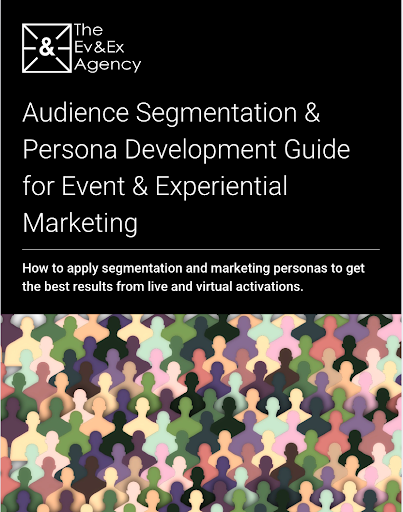Developing an audience segmentation strategy for your event and experiential campaigns is essential in today’s competitive, data-driven marketing environment. It’s comparable to setting your GPS before a road trip: you may reach your destination without it, but you’re more likely to end up lost or stranded. By categorizing your audience into targeted, actionable groups, you align your business objectives with real-world opportunities, enhancing your ability to connect with the right people at the right time.
In our first post in this series, we looked at exactly what audience segmentation was for experiential marketing. Now let’s unpack why audience segmentation can be revelatory for your campaigns, and how it delivers measurable benefits.
Identifying Opportunities
A solid segmentation strategy helps uncover high-potential market segments that you might otherwise miss out on. That’s the gold in a mountain of data, the nuggets of insight that can lead to effective and profitable events and experiences. For example, let’s say you observe a trend in customer feedback and market data indicating a growing interest in eco-friendly events.
This isn’t merely a passing fad; it’s a cultural shift. By acting on this insight, you could develop a marketing plan that emphasizes sustainability, such as participating in green festivals or hosting carbon-neutral pop-up events. Now, instead of just keeping up with trends, you’re staying ahead of them. Segmentation helps identify untapped opportunities.
Let’s say you’ve typically held events in major urban centers, but your data shows rising interest in smaller, offbeat locations. So it might be worth exploring unconventional venues. Hosting a quirky pop-up event in an unexpected place—like a rooftop garden or an art deco warehouse—could generate surprising buzz and engagement. These unique approaches often lead to significant ROI when they’re supported by insights derived from segmentation.
Targeting Marketing Efforts
A one-size-fits-all approach to marketing is no longer effective. Consumers now expect personalization, and segmentation allows you to meet that expectation. By creating campaigns that address the specific needs and desires of each audience segment, you foster a deeper connection and increase the likelihood of conversion.
For example, consider a tech conference. Your audience might include developers, startup founders, and investors—three groups with very different priorities. A segmentation strategy enables you to tailor your messaging for each group. Developers might receive emails highlighting coding workshops, founders could be invited to startup pitch contests, and investors might see content that emphasizes networking opportunities with innovative companies.
The outcome? Each group feels that the event was designed specifically for them. This customized approach not only drives higher attendance but also builds loyalty. When customers recognize that you genuinely understand their preferences, they are more likely to return—and recommend your event to others. By demonstrating that you care about their individual needs, you can transform attendees into brand ambassadors.
Creating a Competitive Advantage
Segmentation offers you a strategic advantage in outmaneuvering competitors. By pinpointing market gaps that others have overlooked, you can develop innovative solutions that elevate your events above the rest. Take, for example, the oh-so-saturated arena of food festivals. If your segmentation analysis identifies an underserved demographic—such as vegan culinary enthusiasts—you have an opening to curate a specialized event tailored to their interests. Envision plant-based cooking demonstrations, exclusive access to vegan products, and collaborations with eco-conscious brands. This not only addresses a market void but also positions you as a pioneer within the industry.
Furthermore, customization enhances your competitive edge by allowing you to offer tailored event packages and specialized activities for distinct audience segments. For instance, creating VIP lounges for social media influencers or interactive workshops designed for families fosters a compelling value proposition. This differentiation can transform your event from a mere gathering into *the* event that captures widespread attention and discussion.
Identifying Market Gaps
The event landscape is littered with examples of well-intentioned campaigns that faltered and flopped due to entering overcrowded markets or misunderstandings of consumer demand. Applying segmentation can help avoid these challenges by offering a clearer understanding of the competitive dynamics in various areas. Take, for instance, the planning of a music festival. Skipping segmentation means you might be tempted to book mainstream pop artists, unknowingly competing with numerous similar festivals. But by analyzing your audience, you might uncover a rising interest in indie folk music among millennials in your area.
By honing in on this niche, you can navigate around the competition and establish a distinct presence in the market. Additionally, segmentation aids in refining your event’s positioning. It helps identify not only what your audience seeks but also what they actively avoid—such as overcrowded venues, generic programming, or unsustainable practices. By tackling these concerns, you can craft a unique offering that truly resonates with your audience.
Collaboration and Alignment
Effective segmentation transcends mere campaign enhancement; it plays a pivotal role in fostering cohesion within your organization. When all departments—ranging from marketing and sales to operations and creative teams—are unified in their understanding of target audiences and positioning, remarkable outcomes emerge. Communication becomes fluid, inefficiencies diminish, and strategic vision flourishes.
Consider the scenario of launching a new experiential campaign. Your segmentation strategy identifies three primary audience categories: tech aficionados, environmental advocates, and families. Armed with these insights, your marketing team can develop targeted messaging, your creative team can design bespoke experiences, and your sales team can engage potential sponsors aligned with each segment.
The outcome? A harmonized campaign that exudes coherence and purposeful intent. Moreover, effective segmentation enhances collaboration with external partners. When you can articulate your target audience and the rationale behind it with clarity, sponsors, vendors, and collaborators are more inclined to recognize the value in joining forces with you. Attracting stakeholders becomes simpler when your strategy is underpinned by robust data and well-founded insights.
Segmentation Isn’t Optional
In today’s marketing landscape, where consumer and customer expectations are exceptionally high, audience segmentation has become essential rather than optional. It’s the cornerstone for crafting events and experiences that truly connect, engage, and yield meaningful results. By pinpointing opportunities, fine-tuning marketing strategies, carving out a competitive edge, identifying market gaps, and promoting alignment, segmentation transforms confusion into coherence and potential into profit.
Think of segmentation as your baseline strategic guiding principle. It directs your decision-making, optimizes the use of your resources, and ensures that your campaigns remain centered on what truly matters: building genuine connections with your audience. Whether organizing a corporate gala, a music festival, or a product launch, a thoughtfully implemented segmentation strategy is crucial for success.
Abandoning guesswork in favor of segmentation is vital. In the realm of events, understanding your audience isn’t merely part of the process—it’s the entire mission. If you’d like help in making audience segmentation a powerful tool in your event and experiential marketing arsenal, we’re ready to lend a hand. Just reach out to us today!


